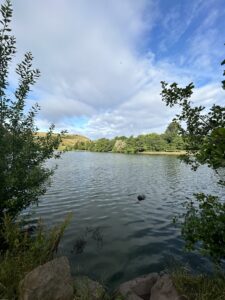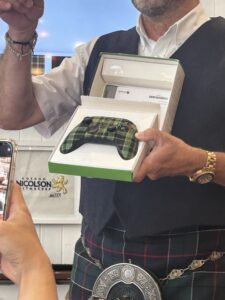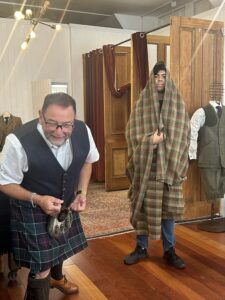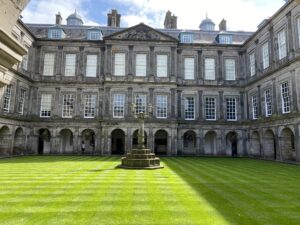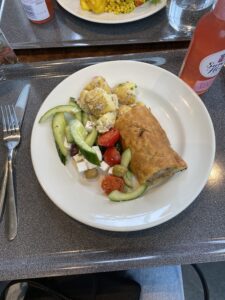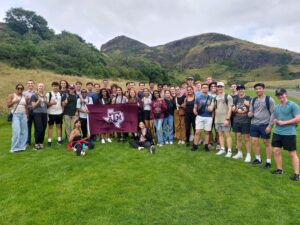Howdy everyone!
Today was the third day spent in Edinburgh, Scotland, and what an eventful day it was. Kicking off the day at 6:15 sharp with an early morning run, Tommy, Colin, Ashwin, Rudolf, Cadin, Mary Faith, Jack, Anisha, Carson, Nic, Christian, Andrew C, and Seth, had an adventurous four mile run to the beach of Edinburgh. The more experienced runners made an amazing pace, reaching the docks of Edinburgh to admire the sea and running back in time for breakfast. However, two of the less experienced, yet adamantly determined runners, separated from the group, on accident, and ran down to the Beach Walk to see the sun.
After resting, the two made their way through the streets of Edinburgh, relying solely on an unreliable offline map. After asking many locals of Edinburgh for directions and enjoying a few scenic trails, the two finished their trek back to the dorm halls. Although they were an hour behind their fellow runners, it was a worthwhile diversion.
After the runners returned and everyone ate breakfast, we all gathered to go to a famous kilt maker in the heart of Edinburgh known as Gordon Nicholson. He is renowned for his many commission works for weddings, various events, and numerous corporate clients including Xbox, Kia, and Celtic FC.
For those unfamiliar, the kilt is a skirt like garment worn by the people of Scotland on many daily occasions, but especially on weddings, graduations, and other important events. Each kilt is marked by a tartan, a distinctive striped or checkered pattern that makes each kilt a source of identity for its owner.
In the early days, kilts were made using various natural dyes. Bugs and beetles for the red, blue was from lots of local fruit and flowers, and yellow from animals. A problem arose form these natural dyes, however. A dyed kilt was only good until it rained. After a downpour, the water would wash away the dye until came along stale urine, yes urine. Ammonia concentrations increase the more concentrated the urine becomes. (stemming from the urea). Ammonia acts as a stabilizer for the color so the worse the kilt smelled, the better its craftsmanship…
Today, most tartans are factory made and so it isn’t difficult to make a new pattern. But, a tailored kilt often runs thousands of pounds. Why? The secret is in the craftsmanship. Each kilt is marked by its distinctive pleating. A kilt might be adorned with the military pleat or box pleat or any other the craftsman may be skilled in.
We learned many of those craftsman are trained in the Edinburgh Kiltmaker School where apprentices train for many months to be able to make these intricate pieces of craftsmanship. I got to see a bit of the maker’s skill in action when I donned an early farmer’s kilt. The fabric seemed incredibly versatile as he adjusted it into a hoodie, jacket, raincoat or whatever else I could imagine in a few movements of the fabric. Complete with a shield and sword, it turned into a Celtic soldier’s uniform.
All in all, we were all impressed to see the great craftsmanship and detail that went into these kilts and how rich and deep its history was.
After the kiltmaker, we made our way to the Palace of Holyroodhouse. This Palace is a working palace, meaning it is still used by the current King when carrying out engagements in Scotland; this can lead to unexpected closures to specific exhibits should the need arise for a fully functional Palace, but we were fortunate enough to experience the full tour uninterrupted.
We followed in the footsteps of royal processions of yore as we traversed through the Palace of Holyroodhouse. First we toured the state apartments where the King and Queen resided. With the intricate plasterwork ceilings and stunning French and Flemish tapestries, it was a veritable feast for the eyes as our audio tour narrated the history of each room. We learned about the murder of Mary, Queen of Scott’s private secretary David Rizzio that was staged by her jealous husband, and got to see the bloodstain from the night he died.
Afterwards, we moved outside to examine the Holyrood Abbey, one of the grandest medieval abbeys in Scotland. The Abbey was founded in 1128 after King David I saw a vision of a stag with a cross or ‘rood’ between its antlers while hunting; this is what lead to the name “Holyrood” for the palace! Although part of the Abbey is in ruins, we were able to use the digital devices given to us for the audio tour to overlay paintings of what the Abbey used to look like over the ruins.
For our final part of the tour, we meandered through the Palace gardens bursting with color. We marveled at the ornate sundial in the center of the King’s garden and learned all about the physics garden, which originated in the 17th century to teach students about the medicinal properties of plants. Once we had completed the tour, we all ate a proper Scottish lunch at a nearby restaurant.
After our tour of Holyrood Palace, we set off on a hike to the peak of Arthur’s Seat, a large hill next to the dorm halls. We trekked to the base of the hill, and got a quick photo with everyone before we began our ascent.
We began the hike and had many different approaches to the climb, many rushing ahead to get up to the summit as soon as possible, and others pacing themselves to enjoy the scenery as they went. The hike was challenging, but not impossible, with rocky paths and many many stairs to climb in order to get to the top. It was all worth the work, as the top of the hill had one of the greatest views of Edinburgh and the North Sea just off the shore.
After getting our pictures and enjoying the view for some time, the descent began. A few different paths were taken, with one even attempting to take the path down a steep rock cliff with a narrow passageway to the main trail below, making a decent attempt to get to the bottom before turning around and opting for another path. This path was also difficult, with smooth rocks and slopes where everyone carefully watched their steps, and made it back down safely to meet up with the group that had taken the easier route that we had climbed up from.
We had an amazing time learning about Edinburgh’s kilt culture, touring the opulent Holyrood Palace, and finishing out with a great physical climb to the peak of Arthur’s seat. All these moments will surely be cemented in our memories for years to come, and the days to come will no doubt be filled with even more. Thank you for taking the time to read the blog post, and we’ll see you tomorrow for the next entry.
Gus an ath uair!
– Aayan, Anisha, and Ashwin



